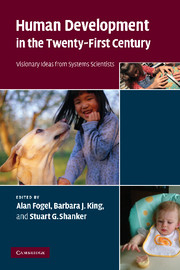Book contents
- Frontmatter
- Contents
- List of contributors
- Introduction: Why a dynamic systems approach to fostering human development?
- Part I Dynamic relationships between genetics and environments
- Part II The dynamic system of the child in the family
- Part III The dynamic system of the child in social and physical environment
- Part IV Dynamic systems approaches to mental health
- 17 A dynamic developmental model of mental health and mental illness
- 18 Dyadic microanalysis of mother–infant communication informs clinical practice
- 19 Current problems of Japanese youth: some possible pathways for alleviating these problems from the perspective of dynamic systems theory
- 20 A different way to help
- 21 Why do siblings often turn out very differently?
- 22 A dynamic systems approach to understanding family and peer relationships: implications for effective interventions with aggressive youth
- 23 Prenatal substance exposure and human development
- Part V Conclusions and outlook
- Index
- References
19 - Current problems of Japanese youth: some possible pathways for alleviating these problems from the perspective of dynamic systems theory
Published online by Cambridge University Press: 22 September 2009
- Frontmatter
- Contents
- List of contributors
- Introduction: Why a dynamic systems approach to fostering human development?
- Part I Dynamic relationships between genetics and environments
- Part II The dynamic system of the child in the family
- Part III The dynamic system of the child in social and physical environment
- Part IV Dynamic systems approaches to mental health
- 17 A dynamic developmental model of mental health and mental illness
- 18 Dyadic microanalysis of mother–infant communication informs clinical practice
- 19 Current problems of Japanese youth: some possible pathways for alleviating these problems from the perspective of dynamic systems theory
- 20 A different way to help
- 21 Why do siblings often turn out very differently?
- 22 A dynamic systems approach to understanding family and peer relationships: implications for effective interventions with aggressive youth
- 23 Prenatal substance exposure and human development
- Part V Conclusions and outlook
- Index
- References
Summary
Yoshiko wouldn’t reveal her son's name, because of fears that her neighbors in a suburb of Tokyo might find out. Three years ago, a classmate taunted her seventeen-year-old son with anonymous hate letters and abusive graffiti about him in the schoolyard. After that, he went into the family's kitchen, shut the door, and refused to leave and he hasn't left the room since then or allowed anyone in. The family eventually decided to build a new kitchen and Yoshiko takes meals to her son's door three times a day. There is a toilet next to the kitchen, but the boy has bathed only twice each year (adapted from a story by Phil Rees, BBC News, Sunday, October 20, 2002).
In this chapter, we will discuss the problem of Japanese adolescents and young adults called hikikomori, in which the teenager remains isolated in one room at home with limited contact with the outside world, perhaps via the internet, and with little or no communication with family members. They may make late-night shopping expeditions, leaving the home after parents are sleeping and avoiding any face-to-face contact with others, or they may not leave at all. The condition can last for many months or even years. There are believed to be over one million cases of hikikomori currently in Japan, which results in huge economic and social losses. In some cases, if parents seek to end the situation or force the child out, there can be violent attacks against the parents.
- Type
- Chapter
- Information
- Human Development in the Twenty-First CenturyVisionary Ideas from Systems Scientists, pp. 188 - 199Publisher: Cambridge University PressPrint publication year: 2007
References
- 1
- Cited by

